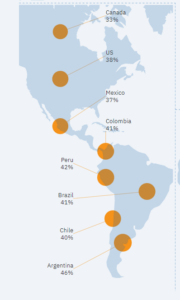The Reuters Institute's Digital News Report 2023 reveals a declining interest in news in several Latin American countries and the world, as well as a growth in the use of platforms such as Youtube and TikTok for information.
The report shows that, unlike Twitter and Facebook, users of TikTok, Instagram and Snapchat tend to pay more attention to celebrities than to journalists or media when it comes to information. Also, the public admits to becoming less and less informed through news sites.
"Younger generations have little interest in many of the conventional news offerings geared to the habits, interests and values of older generations, and are instead turning to the more personalized and participatory options offered by social media, often looking away from traditional platforms and looking to new entrants (many of whom generate little traffic for the media and do not prioritize news)," said Rasmus Nielsen, Director of the Reuters Institute, on the occasion of the report's launch.
One country at the top of the list for TikTok adoption for news is Peru. Thirty percent of young people surveyed in that country use the Chinese video platform to consume news. No other Latin American country surveyed for this report has similar numbers.
Peru was hit hard by COVID-19, and the slow economic recovery is worrying for media companies. Advertising investment reached 0.23% of GDP, well below 2017 levels (0.31%); explains the Reuters Institute report.
Mexico and Brazil also show significant growth in the use of TikTok. Many of the news companies are trying to find ways to attract younger audiences through this platform.
According to the report, in Brazil the three best-selling newspapers (O Globo, Folha de S. Paulo and O Estado de S. Paulo) have accounts on TikTok, but still have a larger number of followers on Instagram and Twitter. And that happens to other TV networks who are also interested in TikTok, but find it easier to promote their content on other social media.
Countries such as Chile, Argentina and Colombia have reported that consumers are experiencing news fatigue, according to the report.
For example, Argentina is among the countries with the lowest level of trust in the media. Overall trust in that country has declined 5 percentage points in the past year, from 35% to 30%. In addition, trust in the media sources that respondents said they use has also dropped from 42% to 36%.

Map of the American continent with percentages of news avoidance by country. (Photo: Screenshot- Reuters Institute)
In Chile, after a time period that has seen riots, COVID-19 and controversial elections, viewers are experiencing news consumption fatigue.
Four in ten (40%) of Chilean participants in the Digital News Report survey said they sometimes or often avoid news, a slightly higher figure than in 2022 (38%). According to respondents, national politics is one of the topics they avoid the most.
This is also the case in Colombia. Colombians actively avoid news (41%), especially news related to the country's political current affairs or crime. In addition, respondents to the report said they consult news sources less frequently (25%) than before.
Even so, media subscriptions in Colombia do not yet seem to be affected. “14% of respondents said they paid for a subscription, 2 percentage points higher than last year. El Tiempo and El Espectador are using AI and other automatic technologies to find successful ways to convert users into subscribers,” according to the report.
The report shows how politicians have become one of the main sources of criticism of journalists and the media, ahead of ordinary citizens and influential people. Social media is the most common way in which people said they are exposed to this criticism.
An example of the above has been Mexico, “the president’s repeated attacks against news companies may have impacted the steady decline in trust in the news over the last few years from 50% in 2019 to 36% today. Most of the top news brands have seen further declines in their individual trust scores this year, with CNN outperforming local brands,” stated the report.
On the other hand, regarding misinformation, 56% of global respondents said they are concerned about distinguishing the difference between real and fake news on the Internet, up two percentage points from the 2022 report.
In addition, the report also explains that news podcasts continue to resonate with educated and younger audiences, but remain a minority activity overall.
The Digital News Report 2023 is the product of a survey of 46 markets. The total sample size was 93,895 adults, with about 2,000 per market. Fieldwork was conducted in late January and early February 2023.
The report is now available in English and will also be launched in Spanish at the Gabo Festival in late June.